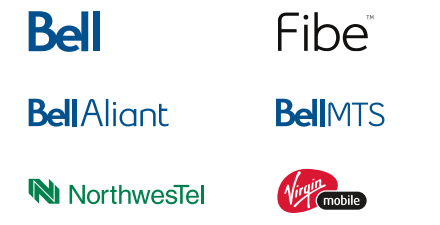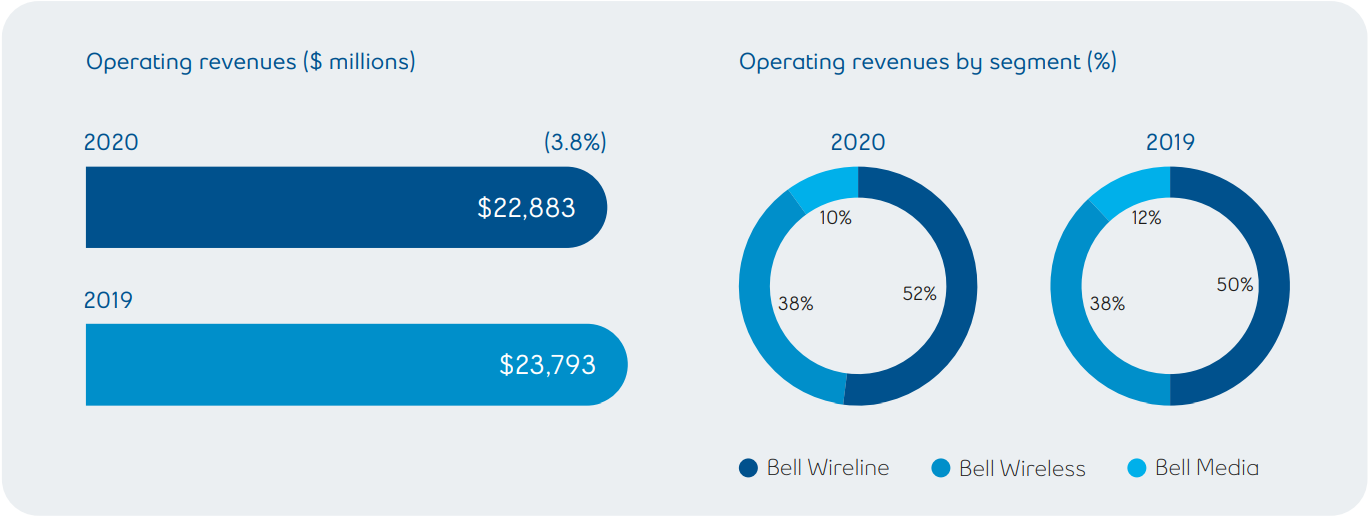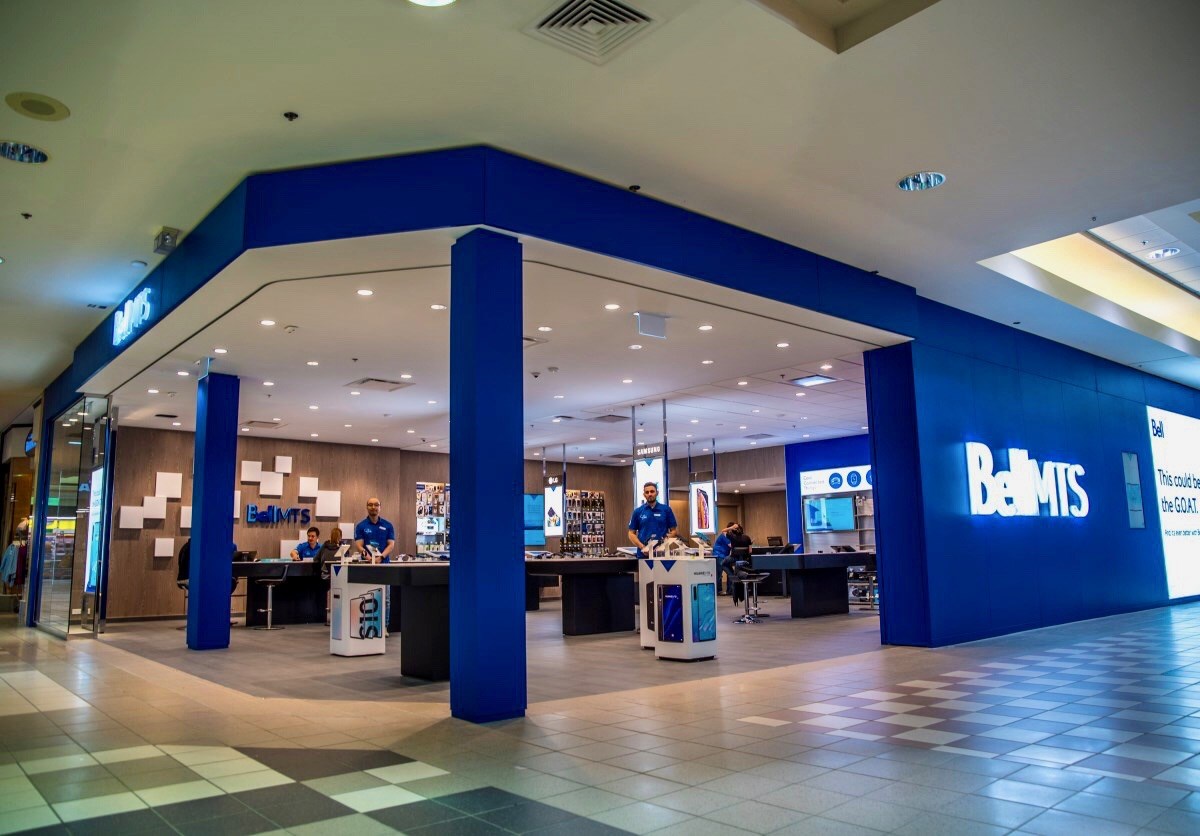BCE
Summary
- BCE is Canada’s largest communications company
- Bell Media operates the country’s top media brands, such as CTV, V, TSN, RDS, Crave, Noovo and iHeartRadio,
- With its extensive network of Bell, Virgin Mobile, Lucky Mobile and The Source locations, BCE is also one of Canada’s biggest retailers.
- The company is Canada’s broadband leader providing advanced wireless, Internet, TV, smart home and business services over its world-class LTE and fiber networks under brand name Bell.

Company Overview
Bell Canada Enterprises (NYSE:BCE, TSX:BCE) Leveraging the power of its world-class wireless and fibre networks, BCE delivers a wide range of service innovations to consumers, businesses and government customers across Canada including LTE Advanced, Fibe Internet and TV, Wireless Home Internet, cloud and data hosting, IP voice and collaboration, Connected Cars, Smart Cities and Internet of Things.1
Bell Media operates the country’s top media brands, such as CTV, V, TSN, RDS, Crave, Noovo and iHeartRadio, and is a leading investor in Canadian content creation, including local television and radio news, sports and entertainment programming, and other original TV and film productions. With its extensive network of Bell, Virgin Mobile, Lucky Mobile and The Source locations, BCE is also one of Canada’s biggest retailers.

Major Milestones
| Year | Development |
| 1876 | Alexander Graham Bell started up a telephone company in Canada. |
| 1877 | Launch of the Bell telephone |
| 1880 | The Bell Telephone Company of Canada is incorporated by Federal charter on April 29. |
| 1881 | Bell installs its first public telephone outside its offices in Hamilton, Ontario. |
| 1881 | Bell constructs its first long distance line between Hamilton and Toronto. |
| 1927 | Bell introduces new receiver-transmitter sets, ushering in the era of combination handset telephones. |
| 1929 | Bell moves its head office from 118 Notre-Dame Street West to 1050 Beaver Hall Hill. Designed by architects Barott and Blackader of Montréal, it was the city's second tallest structure at the time. |
| 1947 | Bell launches Canada’s first commercial mobile telephone service. |
| 1953 | Bell establishes the first permanent television link between 2 countries, bringing US programming from Buffalo, New York, to the Canadian Broadcasting Corporation in Toronto. |
| 1960 | Bell introduces All Number Calling (7-digit telephone numbers). |
| 1961 | Bell introduces the Bellboy wireless paging system. |
| 1964 | Bell inaugurates Touch-Tone service, transforming the telephone into a data terminal. |
| 1968 | The new corporate name “Bell Canada” is authorized on March 7. |
| 1974 | Bell deploys our first 9-1-1 emergency calling system for police, fire and ambulance. |
| 1977 | Bell is the first to use fibre-optic technology on a public network, laying the foundation for today’s all-fibre consumer and business connections. |
| 1999 | Bell is the first in North America to offer mobile Internet services. |
| 1999 | BCE Mobile Communications Inc. becomes a wholly owned, indirect subsidiary of Bell Canada and is renamed Bell Mobility Inc. |
| 2002 | Bell Mobility launches the first 3G network in Toronto with 1X. |
| 2010 | The launch of Bell Fibe TV, our next-generation Internet Protocol Television (IPTV) service. |
| 2015 | Bell becomes the largest TV provider in Canada. |
| 2017 | The fastest wireless gets faster. Bell Mobility network becomes the first in North America capable of delivering Quad Band LTE Advanced speeds. |
| 2019 | Bell completes the shutdown of our CDMA wireless network on April 30 to further enhance our industry-leading 4G LTE network. |
| 2020 | Bell turns on Canada’s largest 5G wireless network. |
| 2021 | In July, Virgin Mobile is rebranded to Virgin Plus. |
Brands
- Bell -Canada’s broadband leader providing advanced wireless, Internet, TV, smart home and business services over its world-class LTE and fibre networks.
- Bell Aliant - Atlantic Canada’s leading name in residential Internet, TV, and home phone services, and a trusted partner to business and public sector clients.
- Bell Media - Canada’s leading content creation company with premier assets in television, radio, out-of-home advertising, and digital media.
- Bell MTS - Manitoba’s top name in home and business communications, and a leader in managed data and professional services through its Epic subsidiary.
- Lucky Mobile - Low-cost prepaid wireless featuring convenient account management app and flexible add-ons for data, international calling and more.
- NorthwesTel - Leading investor in communications infrastructure in Canada’s north, providing Internet, TV and phone services over a vast territory.
- The Source - Canada’s largest tech retailer, offering the latest products from top brands and knowledgeable associates at stores across the country.
- Virgin Plus - National provider of pre- and post-paid wireless services with award-winning customer service and innovative Member Benefits.

Business Segments
The company report the results of its operations in three segments: Bell Wireless, Bell Wireline and Bell Media. The company describe its product lines by segment below, to provide further insight into its operations.2
Bell Wireless
Provides integrated digital wireless voice and data communication products and services to residential and business customers across Canada
Includes the results of operations of Bell Mobility Inc. (Bell Mobility) and its national consumer electronics retailer, The Source (Bell) Electronics Inc
Networks and Reach
The company hold wireless spectrum licences, with holdings across various spectrum bands and regions across Canada, totalling more than 4.8 billion megahertz per population (MHz-Pop), corresponding to an average of approximately 137 Megahertz (MHz) of spectrum per Canadian.
The company's Fourth Generation (4G) Long-term Evolution (LTE) and LTE Advanced (LTE-A) nationwide wireless broadband networks are compatible with global standards and deliver high-quality and reliable voice and highspeed data services to virtually all of the Canadian population. The company's 5G network, launched in June 2020, is the next-generation of wireless technology. The company's LTE network will be the backbone for its 5G network as it expands across Canada.
LTE coverage of over 99% of Canada’s population coast to coast, with LTE-A covering approximately 96% of Canada’s population and 5G covering 26% of Canada’s population at December 31, 2020
Peak theoretical mobile data access download speeds: 5G, up to 1.7 Gbps (average expected speeds of 69 to 385 Mbps in the Greater Toronto Area (GTA)); LTE-A, up to 1.5 Gigabit(s) per second (Gbps) (average expected speeds of 25 to 319 Mbps); LTE, up to 150 Mbps (expected average speeds of 18 to 40 Mbps); High-speed packet access plus (HSPA+), up to 42 Mbps (expected average speeds of 7 to 14 Mbps.
BCE has more than 4,600 retail points of distribution across Canada, including approximately 1,200 Bell, Virgin Mobile Canada (Virgin Mobile), Lucky Mobile and The Source locations, as well as Glentel-operated locations (WIRELESSWAVE, Tbooth wireless and WIRELESS etc.) and other third-party dealer and retail locations.

Bell Wireline
Provides data, including Internet access and IPTV, voice, comprising local telephone and long distance, as well as other communication services and products to residential, small and medium-sized business and large enterprise customers, primarily in Ontario, Québec, the Atlantic provinces and Manitoba, while satellite TV service and connectivity to business customers are available nationally across Canada. The company also offer competitive local exchange carrier (CLEC) services in Alberta and British Columbia.
Includes the results of its wholesale business, which buys and sells local telephone, long distance, data and other services from or to resellers and other carriers, and the wireline operations of Northwestel Inc. (Northwestel), which provides telecommunications services in Canada’s Northern Territories
Networks and Reach
Extensive local access network in Ontario, Québec, the Atlantic provinces and Manitoba, as well as in Canada’s Northern Territories
Broadband fibre network, consisting of fibre-to-the-premise (FTTP) and fibre-to-the-node (FTTN) locations, covering approximately 9.9 million homes and businesses in Ontario, Québec, the Atlantic provinces and Manitoba. The company's FTTP direct fibre footprint encompassed approximately 5.6 million homes and commercial locations at the end of 2020, representing the largest FTTP footprint in Canada.
Wireless-to-the-premise (WTTP) footprint approaching 50% of its target of 1 million locations primarily in rural areas. WTTP is 5G-capable fixed wireless technology delivered over Bell’s LTE wireless network that provides broadband residential Internet access to smaller and underserved communities.
Largest Internet protocol (IP) multi-protocol label switching footprint of any Canadian provider, enabling it to offer business customers a virtual private network (VPN) service for IP traffic and to optimize bandwidth for real-time voice and TV
More than 700 Bell and Virgin Mobile locations

Bell Media
Canada’s leading content creation company with premier assets in video, radio, OOH advertising and digital media
Revenues are derived primarily from advertising and subscriber fees
Assets and Reach
Video
- 35 conventional TV stations, including CTV, Canada’s #1 TV network for 19 consecutive years, and the French-language Noovo network in Québec
- 27 specialty TV channels, including TSN, Canada’s most-watched sports channel and RDS, the top French-language sports network
- 4 pay TV services and 3 direct-to-consumer (DTC) streaming services, including Crave, the exclusive home of HBO in Canada
Radio
- 109 licensed radio stations in 58 markets across Canada
OOH Advertising
- Network of more than 50,000 advertising faces in key urban cities across Canada
Digital Media
- More than 200 websites and more than 30 apps
Broadcast Right
Sports : long-term media rights to key sports properties and official Canadian broadcaster of the Super Bowl, Grey Cup and International Ice Hockey Federation (IIHF) World Junior Championship. Live sports coverage includes the Toronto Maple Leafs, Montreal Canadiens, Winnipeg Jets and Ottawa Senators, Canadian Football League (CFL), National Football League (NFL), National Basketball Association (NBA), Major League Soccer (MLS), Fédération Internationale de Football Association (FIFA) World Cup events, Curling’s Season of Champions, Major League Baseball (MLB), Golf’s Majors, NASCAR Cup Series, Formula 1 (F1), Grand Slam Tennis, Ultimate Fighting Championship (UFC), National Collegiate Athletic Association (NCAA), March Madness and more.
- HBO: long-term agreement to deliver all current-season, past-season and library HBO programming in Canada exclusively on its linear, on-demand and OTT platforms
- HBO Max: long-term exclusive agreement to deliver original, non-children’s programming produced by Warner Bros. Television Group for HBO Max
- SHOWTIME: content licensing and trademark agreement for past, present and future SHOWTIME-owned programming
- STARZ: long-term agreement with Lionsgate to deliver U.S. premium pay TV platform STARZ in Canada
- iHeartRadio: exclusive partnership for digital and streaming music services in Canada

Financial Highlights
BCE Third Quarter 2021 Results
November 4, 2021; BCE Inc. reported results for the third quarter (Q3) of 2021.3
“With a clear strategic roadmap to build back from the impacts of COVID-19 and invest in the growth opportunities ahead, its team delivered positive performances across all Bell operating segments in Q3. Bell’s leading fibre and 5G broadband networks, and the wireline, wireless and media innovations they enable, are clearly delivering the connections Canadian consumers and business customers need as the company all work to recover from the impacts of the COVID crisis,” said Mirko Bibic, President and CEO of BCE Inc. and Bell Canada.
“As pace of its recovery from the crisis quickens, the strong demand for the speed and connectivity advantages of Bell’s leading networks and services is clearly reflected in its Q3 results. The company's fast-growing fibre network powered Bell’s best quarterly retail Internet net subscriber activations in 15 years and a 9% increase in residential Internet revenue as the company also grew IPTV net subscriber activations by 68%. At the same time, the unparalleled performance advantages of Bell’s wireless networks drove a 46% increase in postpaid mobile phone net additions and exceptional growth in service revenue and adjusted EBITDA.”
“The Bell team has achieved its objective to steadily improve results each quarter since Q2 2020, when its business experienced its heaviest impacts from the COVID crisis. BCE has grown total revenue and adjusted EBITDA back to the levels of pre-pandemic Q3 2019 while at the same time significantly accelerating its next-generation network infrastructure investments to help its customers and company come back better from the COVID crisis. As reflected in the Bell for Better initiative, including the historic two-year $1.7 billion acceleration in its 5G, fibre and rural network rollouts, the Bell team is committed to championing customer experience, investing in its communities and driving its country’s ongoing recovery and resurgence.”
Key Business Developments
Building the best network: Canada’s fastest 5G
Executing its accelerated network investment plan with a 12.4% increase in capital expenditures in Q3, Bell network rollouts included pure fibre Internet for 52 smaller communities in Manitoba, Ontario, Québec and the Atlantic provinces and Bell 5G in communities large and small across multiple provinces. Bell is on track to meet or exceed its 2021 targets for new fibre and Wireless Home Internet locations passed, and to offer 5G coverage to more than 70% of the national population by the end of the year.
PCMag again determined that Bell’s mobile networks are the fastest in the country in its latest national network performance tests, while Global Wireless Solutions (GWS) ranked Bell 5G as Canada’s best. With the most awarded 5G network in Canada, Bell is driving the next generation of mobile innovation including the expansion of TSN 5G View / Vision 5G RDS access to Toronto Raptors home games in addition to regional coverage of the Montréal Canadiens and Toronto Maple Leafs; a 5G collaboration with Tiny Mile for its fleet of food delivery robots in downtown Toronto; and a partnership with TikTok Canada to power its unique Paint Portal multi-user Augmented Reality effect.
Leading the digital transformation of Canadian business
Building on Bell’s strategic agreement with Amazon Web Services (AWS) to accelerate 5G innovation and cloud adoption, we’re working with VMware Cloud and AWS to support enterprise business and government organizations in managing their hybrid cloud strategies. Bell is also offering enterprise customers a portfolio of Software-as-a-Service (SaaS) solutions to support their digital transformations, including Smart Supply Chain by Bell IoT Smart Connect for fleet and supply chain operators. We’re also working with Esri, Canada’s leading geographic information system (GIS) provider, on the Bell Integrated Smart City Ecosystem and with international AI-powered contact centre software provider NICE, to expand access to NICE CXone for Contact Centre as a Service in Canada.
Expanding consumer choice with service innovation, compelling content
Delivering new options for mobility and media customers, Virgin Plus reduced pricing on mobile data plans, achieving the federal government’s 25% price reduction target well ahead of the January 2022 deadline, and Bell Media announced Crave Mobile, offering access to the streaming service’s unparalleled content library on a single mobile device, and Crave Total for multiple user access across a full range of screens.
Canada’s top-ranked sports networks TSN and RDS are delivering more major league sports action this fall-winter season including the Toronto Raptors, the CFL, and the NFL on CTV as well as TSN and RDS. CTV Comedy Channel remained Canada’s most watched entertainment specialty channel for the third year in a row, while Noovo continues to lead viewership growth in conventional French-language TV. The Noovo Info news service aired its first French-language federal leaders debate and election night coverage alongside CTV’s coverage in English. Reflecting a focus on accelerating digital revenue growth, Bell Media launched the Bell DSP adtech platform with advanced advertising company Xandr.
Bell for Better: Mental health in the community
To mark Mental Illness Awareness Week, Bell Let’s Talk announced the 113 recipients of the 2021 Bell Let’s Talk Community Fund in every region of Canada, including South and Central Health Foundation in Grand Falls-Windsor, Newfoundland and Labrador; Legacy of Hope Foundation in Gloucester, Ontario; and Le Centre de Prévention du Suicide (CPS) Côte-Nord in Baie-Comeau, Québec. Bell Let’s Talk also introduced a mental health podcast series featuring mental health experts and guests from Black, Indigenous and People of Colour (BIPOC) communities, and a mobile app in partnership with Strongest Families Institute (SFI) to enhance access to SFI’s proven mental health programs for remote communities.
Bell continues to abide by its COVID-19 operating principles and all government protocols, with a focus on protecting the health and safety of its customers, colleagues and communities. In preparation for a gradual and voluntary return to Bell office locations for more team members this fall, the company introduced the Bell Workways program to provide many of its employees with flexible remote and mobile work options and are implementing a mandatory vaccination policy for Bell team members nationally.
“The company's consolidated Q3 financial results demonstrated another step forward in its COVID recovery and continued strong operational execution, including strong residential wireline performance, industry-leading wireless service revenue and adjusted EBITDA growth, and higher advertising revenue across all TV platforms. Total revenue and adjusted EBITDA are essentially back to Q3 2019 levels with BCE service revenue up 3.6% and adjusted EBITDA 4.2% higher, contributing to a year-over-year increase in net earnings of 9.9% despite ongoing COVID headwinds,” said Glen LeBlanc, Chief Financial Officer for BCE and Bell Canada.
“With strong marketplace performance and free cash flow, bolstered by exceptional liquidity, a well-structured balance sheet and a net debt leverage ratio that is the lowest among its Canadian peers, Bell remains on track to meet its 2021 financial guidance targets, lead investment in next-generation broadband networks and services, and deliver on its capital markets objectives for BCE shareholders.”
BCE operating revenue was up 0.8% over Q3 2020 to $5,836 million, driven by a 3.6% increase in service revenue to $5,099 million reflecting year-over-year increases at all Bell operating segments. Product revenue decreased 14.6% to $737 million, the result of fewer mobile device transactions and lower business wireline data equipment sales.
Net earnings increased 9.9% to $813 million and net earnings attributable to common shareholders totalled $757 million, or $0.83 per share, up 9.4% and 7.8% respectively. The increases were driven by adjusted EBITDA growth and higher other income due mainly to net mark-to-market gains on derivatives used to economically hedge equity settled sharebased compensation. This was partly offset by increased depreciation and amortization expense, higher severance, acquisition and other costs as well as higher income taxes.
Adjusted net earnings were $748 million, or $0.82 per common share, up 5.1% and 3.8% respectively, from $712 million, or $0.79 per common share, in Q3 2020.
Adjusted EBITDA grew 4.2% in Q3 to $2,558 million, driven by year-over-year increases at all Bell operating segments. BCE’s consolidated adjusted EBITDA margin(2) increased 1.4 percentage points to 43.8% from 42.4% in Q3 2020, due to the flow-through of higher service revenue and a 1.7% reduction in total operating costs that reflected a year-over-year decrease in low-margin product sales and the non-recurrence of a number of COVID-19 related expenses incurred last year.
BCE capital expenditures increased 12.4% to $1,159 million, a capital intensity(4) ratio of 19.9%, compared to 17.8% in Q3 2020. The year-over-year increase in capital spending is consistent with its 2-year program to accelerate the rollout of Bell’s 5G, fibre and rural Wireless Home Internet networks.
BCE cash flows from operating activities totalled $1,774 million, down 15.9% from Q3 2020, due to a reduction in cash from the timing of working capital changes and higher income taxes paid, partly offset by higher adjusted EBITDA.
Free cash flow decreased 44.8% to $571 million, compared to $1,034 million in Q3 2020, due to lower cash flows from operating activities, excluding cash from discontinued operations and acquisition and other costs paid, and higher capital expenditures.

Q3 Operating Results By Segment
Bell Wireless
Total wireless operating revenue decreased 0.9% to $2,296 million, due to lower year-overyear product revenue, partly offset by strong service revenue growth.
Service revenue increased 5.0% to $1,654 million, the result of robust mobile phone postpaid subscriber base growth over the past year, driven by its disciplined focus on higher-value smartphone loadings and continued strong demand for Bell’s IoT solutions. Roaming revenue increased modestly over Q3 2020, reflecting increased travel due to easing of COVID-19 restrictions.
Product revenue was down 13.6% to $642 million, due to a reduction in sales transaction volumes attributable to fewer customer device upgrades and a greater mix of bring-yourown-device customer activations.
Wireless adjusted EBITDA increased 5.6% to $1,010 million, reflecting the flow-through of higher service revenue and a 5.6% reduction in operating costs, consistent with lower product sales, which delivered a 2.8 percentage point margin increase to 44.0%.
Bell added 136,464 total net new postpaid and prepaid mobile phone subscriber activations, up 14.3% from 119,345 in Q3 2020.
Postpaid mobile phone net subscriber activations were up 45.9% to 114,821 from 78,706 in Q3 2020. The notable increase was driven by a 9.0% increase in gross subscriber activations, reflecting pent-up customer demand and greater consumer traffic from the reopening of all retail stores compared to last year’s COVID-19 restrictions, and higher direct and digital channel sales volumes. Postpaid mobile phone customer churn improved 5 basis points to 0.93%, representing its best-ever Q3 result.
Prepaid mobile phone net subscriber activations were 21,643, down from 40,639 in Q3 2020. This result can be attributed to a 9.9% decrease in gross activations from lower market activity due to the ongoing slowdown in immigration and international travel during COVID-19. Mobile phone prepaid customer churn increased 17 basis points to 4.15%, reflecting greater competitive intensity in the discount mobile market.
Bell’s mobile phone customer base totalled 9,349,459 at the end of Q3 2021, a 2.7% increase over last year, comprising 8,520,518 postpaid subscribers, up 3.2%, and 828,941 prepaid customers, down 2.2% compared to Q3 2020.
Blended mobile phone average billing per user (ABPU) was up 1.1% to $74.07, driven by greater customer adoption of higher-value rate plans, including unlimited data plans, and a modest year-over-year increase in roaming.
Mobile connected device net activations were down 19.9% to 33,035, despite strong growth in Bell’s business IoT net connections, due to higher data device net losses as the company continue de-emphasizing unprofitable, low-ABPU tablet transactions. Mobile connected device subscribers totalled 2,210,796 at the end of Q3 2021, an increase of 13.0% over last year.
Bell Wireline
Total wireline operating revenue decreased 0.6% to $3,015 million.
Wireline service revenue was up 0.3% to $2,920 million, the result of a 9.1% increase in residential Internet revenue that was partly offset by lower business markets revenue due to exceptionally high demand in Q3 2020 for conferencing services, remote collaboration tools and voice connectivity as a result of work-at-home protocols enacted by Canadian enterprises because of COVID-19 restrictions.
Product revenue decreased 21.5% to $95 million, due to higher sales of data equipment in Q3 2020 as large enterprise and government sector customers spent on capacity and network facilities to connect more employees working remotely, as well as the timing of data equipment sales in 2021.
Wireline adjusted EBITDA grew 1.0% to $1,333 million, reflecting a 1.8% reduction in operating costs that contributed to a 0.7 percentage-point improvement in margin to 44.2%.
Bell added 65,779 net retail Internet subscribers, 4.6% more than Q3 2020. This represents its best quarterly result in 15 years, driven by the accelerated buildout of Bell’s all-fibre and Wireless Home Internet service footprints, and a more active back-to-school period compared to last year. Retail Internet subscribers totalled 3,814,035 at the end of Q3, a 4.2% increase over Q3 last year.
Bell TV added 31,641 net new retail IPTV subscribers, up 68.0% from 18,837 in Q3 2020. This represents its best quarterly result in two years, reflecting the success of its multibrand strategy, including standalone Fibe TV subscriptions and Fibe TV app streaming services, as well as more typical back-to-school student market activity and more live sporting programming this year. At the end of Q3, Bell served 1,853,250 retail IPTV subscribers, up 3.8% from last year.
Retail satellite TV net subscriber losses increased 10.4% to 21,120, due to lower gross activations compared to last year. Bell’s retail satellite TV customer base totalled 875,711 at the end of Q3, down 8.1% compared to last year.
Retail residential NAS net losses improved 14.1% to 42,755, reflecting fewer customer deactivations during COVID-19. Bell’s retail residential NAS customer base totalled 2,338,816 at the end of Q3, a 7.8% decline since Q3 2020.
Bell Media
Media operating revenue increased 14.5% in Q3 to $719 million, driven by increased advertiser spending across TV, radio, out of home and digital media platforms as the COVID-19 economic recovery takes hold more fully, as well as higher subscriber revenue.
Adjusted EBITDA was up 20.8% to $215 million, resulting in a 1.6 percentage point increase in margin to 29.9%. This was driven by the flow-through of higher year-over-year revenue, despite a 12% increase in operating costs reflecting more live sports events and TV programming compared to last year when COVID-19 related TV production shutdowns and delays occurred, and the non-recurrence of Canada Emergency Wage Subsidy (CEWS) funding received in Q3 2020.
Advertising revenue increased 18.6% this quarter, driven by stronger conventional and specialty TV performance, due to a timelier start to the new fall TV programming season, more live sporting events compared to 2020, and revenue generated from the recent federal election.
Subscriber revenue was up 12.3% in Q3, driven by a 5% year-over-year increase in Crave subscribers. Digital revenue grew 32% due to rapid expansion of CTV’s AVOD product, continued scaling of the SAM TV media sales tool and continued Crave growth.
TSN and RDS were Canada’s top-ranked English and French-language sports networks for Q3 and the full 2020/2021 broadcast year.
Bell Media’s English-language entertainment specialty channels achieved record rankings, with CTV Comedy, Discovery and CTV Drama claiming the top 3 spots.
Noovo continued to gain viewership over its French-language competitors with primetime audiences up 18% in the current fall TV season.




